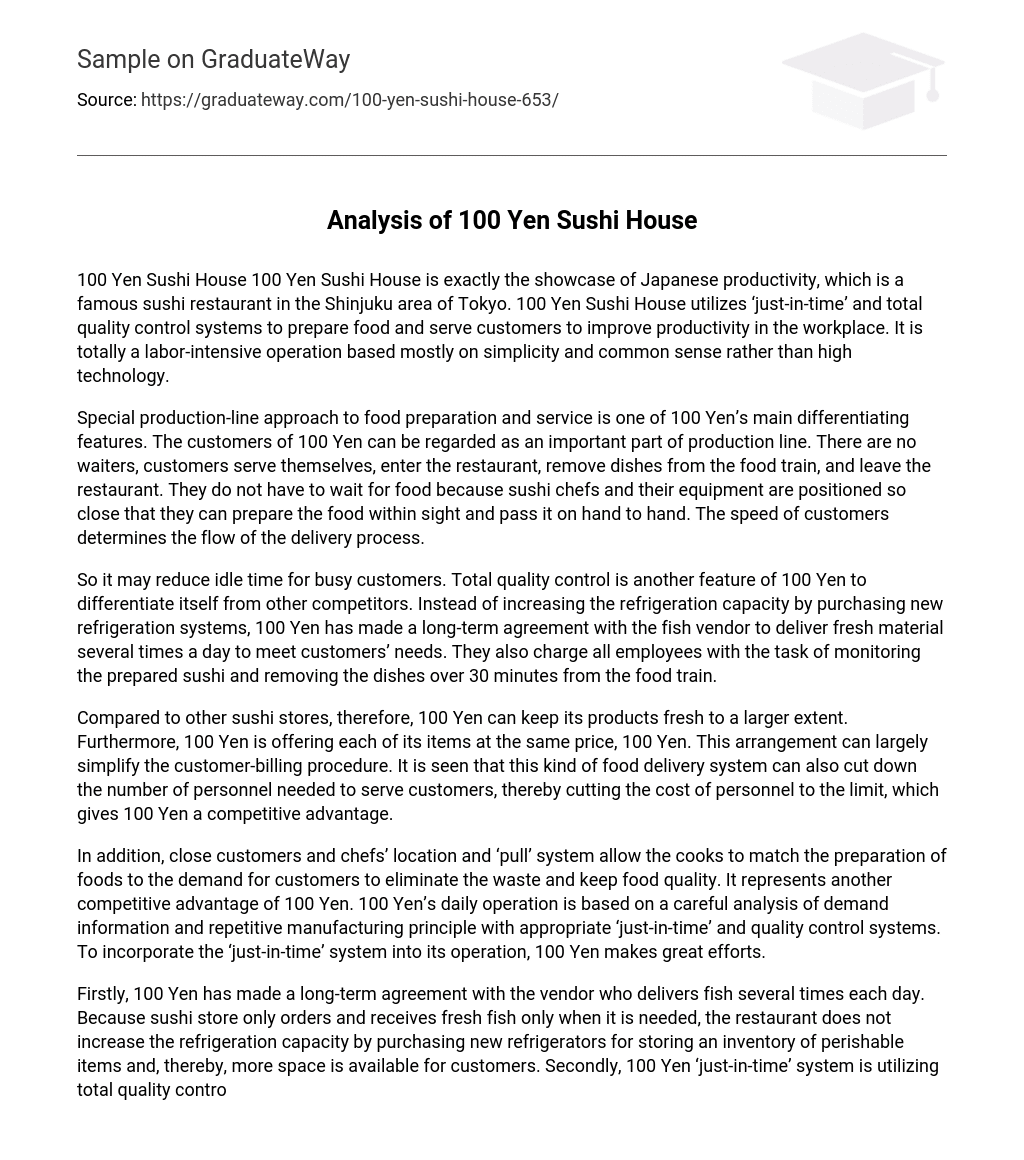100 Yen Sushi House 100 Yen Sushi House is exactly the showcase of Japanese productivity, which is a famous sushi restaurant in the Shinjuku area of Tokyo. 100 Yen Sushi House utilizes ‘just-in-time’ and total quality control systems to prepare food and serve customers to improve productivity in the workplace. It is totally a labor-intensive operation based mostly on simplicity and common sense rather than high technology.
Special production-line approach to food preparation and service is one of 100 Yen’s main differentiating features. The customers of 100 Yen can be regarded as an important part of production line. There are no waiters, customers serve themselves, enter the restaurant, remove dishes from the food train, and leave the restaurant. They do not have to wait for food because sushi chefs and their equipment are positioned so close that they can prepare the food within sight and pass it on hand to hand. The speed of customers determines the flow of the delivery process.
So it may reduce idle time for busy customers. Total quality control is another feature of 100 Yen to differentiate itself from other competitors. Instead of increasing the refrigeration capacity by purchasing new refrigeration systems, 100 Yen has made a long-term agreement with the fish vendor to deliver fresh material several times a day to meet customers’ needs. They also charge all employees with the task of monitoring the prepared sushi and removing the dishes over 30 minutes from the food train.
Compared to other sushi stores, therefore, 100 Yen can keep its products fresh to a larger extent. Furthermore, 100 Yen is offering each of its items at the same price, 100 Yen. This arrangement can largely simplify the customer-billing procedure. It is seen that this kind of food delivery system can also cut down the number of personnel needed to serve customers, thereby cutting the cost of personnel to the limit, which gives 100 Yen a competitive advantage.
In addition, close customers and chefs’ location and ‘pull’ system allow the cooks to match the preparation of foods to the demand for customers to eliminate the waste and keep food quality. It represents another competitive advantage of 100 Yen. 100 Yen’s daily operation is based on a careful analysis of demand information and repetitive manufacturing principle with appropriate ‘just-in-time’ and quality control systems. To incorporate the ‘just-in-time’ system into its operation, 100 Yen makes great efforts.
Firstly, 100 Yen has made a long-term agreement with the vendor who delivers fish several times each day. Because sushi store only orders and receives fresh fish only when it is needed, the restaurant does not increase the refrigeration capacity by purchasing new refrigerators for storing an inventory of perishable items and, thereby, more space is available for customers. Secondly, 100 Yen ‘just-in-time’ system is utilizing total quality control system to make quality the responsibility of every employee instead of leaving it to customers or someone else.
Except ordering fresh materials to keep food fresh, all employees of the restaurant are charged with the task of monitoring the prepared sushi and removing the dishes over 30 minutes from the food train. Thirdly, 100 Yen also uses a special food delivery system, ‘pull system’, rather than a push system. Customers do not have to wait for food. Sushi chefs and their equipment are positioned so close to customers that they can prepare the food for customers within sight and pass it on hand to hand.
It allows the cooks to match the preparation of foods to the demand for customers, thereby eliminating waste. The 100 Yen Sushi House service delivery concepts include ‘pull’ food delivery system and customer self service. Other kinds of services and organizations that could adopt the 100 Yen Sushi House service delivery concepts include welcome eating for customers in the supermarket, delicatessen restaurants or specialty restaurants that are located close to their suppliers. For instance, in delicatessen restaurants, the products are cooked in advance in the back restaurant.
When customers come into the restaurant and choose the product in sight, the employee packages the product immediately. The cooks can prepare the products according to the sales. ———————– Physical Evidence Customer Actions Onstage Contact Person Support Processes Line of Visibility Clean Smell Wait Looks Attractive Food Cash Arrive Greet Find Seat Make Paste Select Plate Remove Uneaten Sushi Replenish Plate **************************************************************** Eat Stake Plates & Pay Leave Fill Tea Take Payment Thank Monitor Demand Fish Supplier Wash Plates





